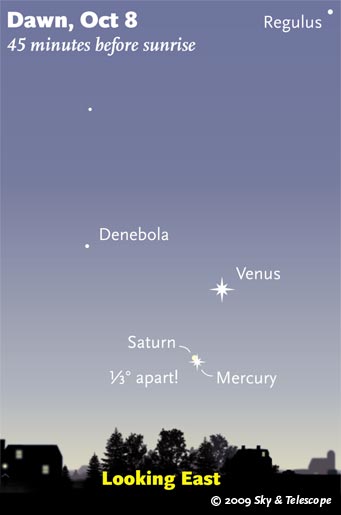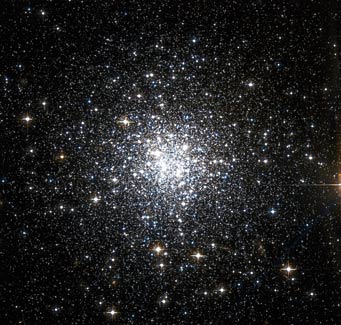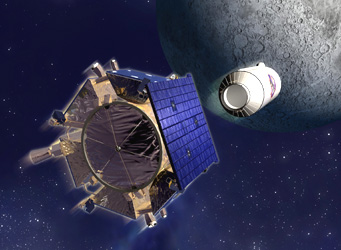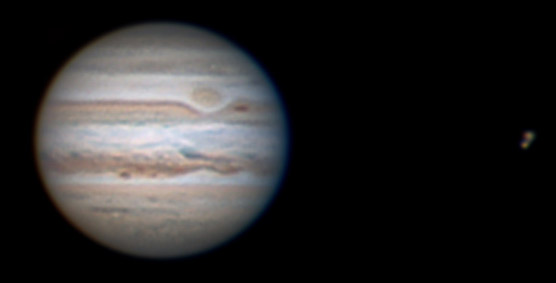Some daily events in the changing sky for October 2 – 10.

This week, keep watch on Mercury and Saturn at dawn as they draw together. They reach conjunction on Thursday morning, as shown here. Bring binoculars; this scene exaggerates their visibility in bright twilight.
Sky & Telescope diagram
Friday, October 2
Saturday, Oct. 3
Sunday, October 4

NGC 6934 in Delphinus is a surprisingly nice sight in medium to large telescopes, though you'll never see it as well resolved as in this Hubble Space Telescope view. For its full splendor, see the larger versions.
NASA / STScI / Wikisky
Monday, October 5
Tuesday, October 6
Wednesday, October 7
Thursday, October 8

Artist's rendition of LCROSS and its Centaur rocket preparing to hit the Moon.
NASA
On September 29th, NASA announced that "based on new analysis of available lunar data, [mission control] has shifted the target crater from Cabeus A to Cabeus (proper).... During the last days of the mission, the LCROSS team will continue to refine the exact point of impact within Cabeus crater to avoid rough spots, and to maximize solar illumination of the debris plume and Earth observations."
See the October Sky & Telescope, page 53, our online followup, and especially our most recent update. Check the LCROSS site for the exact times and other final updates.
Amateurs planning on watching for the event have set up a Google Group. See also NASA's tips on when and how to watch, including a list of events open to the public. Or watch the coverage on NASA TV beginning at 6:30 a.m. Eastern Daylight Time, about an hour in advance of the impacts. The San Francisco Exploratorium will provide a live webcast from Lick Observatory.
Friday, October 9
Saturday, October 10
Want to become a better amateur astronomer? Learn your way around the constellations. They're the key to locating everything fainter and deeper to hunt with binoculars or a telescope. For an easy-to-use constellation guide covering the whole evening sky, use the big monthly map in the center of each issue of Sky & Telescope, the essential magazine of astronomy. Or download our free Getting Started in Astronomy booklet (which only has bimonthly maps).
Sky Atlas 2000.0 (the color Deluxe Edition is shown here) plots 81,312 stars to magnitude 8.5. That includes most of the stars that you can see in a good finderscope, and typically one or two stars that will fall within a 50× telescope's field of view wherever you point. About 2,700 deep-sky objects to hunt are plotted among the stars.
Alan MacRobert
Once you get a telescope, to put it to good use you'll need a detailed, large-scale sky atlas (set of charts; the standards are Sky Atlas 2000.0 or the smaller Pocket Sky Atlas) and good deep-sky guidebooks (such as Sky Atlas 2000.0 Companion by Strong and Sinnott, the more detailed and descriptive Night Sky Observer's Guide by Kepple and Sanner, or the classic Burnham's Celestial Handbook). Read how to use them effectively.
Can a computerized telescope take their place? I don't think so — not for beginners, anyway (and especially not on mounts that are less than top-quality mechanically). As Terence Dickinson and Alan Dyer say in their Backyard Astronomer's Guide, "A full appreciation of the universe cannot come without developing the skills to find things in the sky and understanding how the sky works. This knowledge comes only by spending time under the stars with star maps in hand and a curious mind." Without these, "the sky never becomes a friendly place."
More beginners' tips: "How to Start Right in Astronomy".
This Week's Planet Roundup
Mercury and Saturn are low in the sunrise due east, below landmark Venus. On the morning of October 3rd they're still 4° apart, with Mercury above fainter Saturn. On the morning of the 8th they come to conjunction just 1/3° apart, as shown at right. On that morning Mercury is magnitude –0.8, and Saturn is a forlorn magnitude +1.1. Thereafter Saturn climbs higher each day, while Mercury and Venus hold at about the same altitudes above the horizon. Binoculars will help.
Venus (magnitude –3.9, in Leo) shines due east before and during dawn. Look for Mercury and Saturn below it. Regulus is high to Venus's upper right, by an increasing amount each day.
Mars (magnitude +0.7, in Gemini near Pollux and Castor) rises around midnight or 1 a.m. and is very high in the east before dawn. In a telescope it's still only 6.8 arcseconds wide: a tiny, fuzzy blob, though noticeably gibbous. Mars is on its way to an unremarkable opposition late next January, when it will be 14 arcseconds wide.
Jupiter (magnitude –2.6, in Capricornus) shines in the southeast as twilight fades — the first "star" to appear after sunset. It's highest in the south by 9 p.m.

This year, Jupiter's Great Red Spot has been nicely bordered by the thick white line of the Red Spot Hollow, which indents the dark South Equatorial Belt. Note the very dark red barge following behind the pale Red Spot. The North Equatorial Belt is full of turbulence, including a big blue plume. Far to the right (celestial east), Ganymede and Europa are in conjunction. S&T's Sean Walker took this image at 1:15 UT September 3, 2009. South is up. Stacked-video images like this show much more detail than you're ever likely to see visually on Jupiter.
For all of the Red Spot's central-meridian crossing times, good worldwide, use our Red Spot calculator, or print out our list for the rest of 2009.
S&T: Sean Walker
Uranus (magnitude 5.7, below the Circlet of Pisces) is well up in the southeast during evening. Also catch the 8th-magnitude asteroid 3 Juno in Uranus's vicinity.
Neptune (magnitude 7.8, in Capricornus) is 7° east of Jupiter.
See our finder charts for Uranus and Neptune. For a guide to hunting the challenging satellites of Uranus and Neptune at any date and time (you'll need a fairly big scope), see the October Sky & Telescope, page 59.
Pluto (14th magnitude, in northwestern Sagittarius) is getting low in the southwest after dark.
All descriptions that relate to your horizon or zenith — including the words up, down, right, and left — are written for the world's mid-northern latitudes. Descriptions that also depend on longitude (mainly Moon positions) are for North America. Eastern Daylight Time (EDT) equals Universal Time (also known as UT, UTC, or GMT) minus 4 hours.
To be sure to get the current Sky at a Glance, bookmark this URL:
http://SkyandTelescope.com/observing/ataglance?1=1
If pictures fail to load, refresh the page. If they still fail to load, change the 1 at the end of the URL to any other character and try again.
 0
0
Comments
You must be logged in to post a comment.